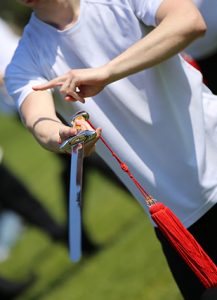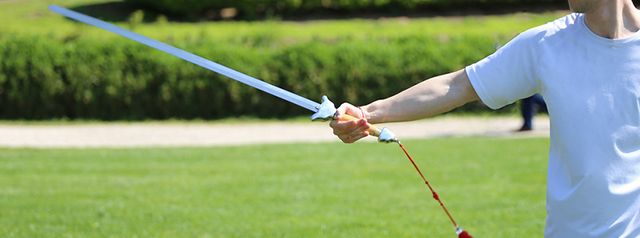豁 Huo/Rip – Expanding to open the opponent while drawing the sword blade across their body
击 Ji/Strike – Like hitting or beating a bell (implying repelling or beating back) with a quick short strike; can also refer to striking with the pommel
架 Jia/Upward Block – Blocking overhead to support the opponent’s weapon above
剪 Jian/Trim – A quick scissoring or clipping motion to shear off a piece of the target
搅 Jiao/Flip – Circling with a stirring motion to cut with the sword tip; also used to describe a circling pivot around an opponent’s weapon while in contact with it
接 Jie/Recieve – This term is used for transferring the sword to the free hand as is done at the end of a form, but can also be done within the form to free up the normally sword wielding hand to do a technique
截 Jie/Intercept – An intercepting block using the edge of the sword against a soft target (typically the wrist or arm of the attacking opponent)
砍 Kan/Cleave – A powerful chop primarily using the forearm (like using a hatchet)
磕 Ke/Jab – Tapping against to knock the opponent’s weapon off target
拉 La/Pull – Deflecting the opponent’s weapon while drawing yours backward
拦 Lan/Parry – Blocking or obstructing using the back edge
攔 Lan/Block – A diagonally across obstruction before the opponent’s force is released
撩 Liao/Stir Up – A typically quick and small upward cut (although it can also be a larger circular upward cut) using the bottom edge of the tip or front edge
捋 Lu/Deflect – To pluck or scrape off like stroking a beard to redirect an opponent’s weapon
履 Lu/Claw – Using a downward pulling motion like a tiger pawing the ground
抹 Mo/Wipe – A short smearing or brushing movement with the middle of the blade and with the tip pointing forward used to pull the opponent’s weapon
拋 Pao/Fling – The sword body moves diagonally across (to either side), like throwing a Frisbee
迸 Peng/Burst – To split or crack open
劈 Pi/Split – A large, powerful chop using the whole arm (like using an axe to split wood)
圈 Quan/Circling – Parrying by taking the opponent’s weapon in a vertical circle
扫 Sao/Sweep – Typically a low attack against the leg or ankle
扇 Shan/Fan – A horizontal slashing cut or used to knock away the opponent’s weapon
势 Shi/Influence –Outward appearance of potential power used to stop an attack
束 Shu/Bind – A vertically held blade use for a drawing in neutralization
提 Ti/Lift – An upward stroke like when lifting something to carry it, typically used to deflect the opponent’s weapon upwards or to cut their wrist from below
 挑 Tiao/Raise – Typically set up by initially using the sword tip to thrust or poke setting up this technique’s springing upward cut or flick with the arm in a straight line with the sword
挑 Tiao/Raise – Typically set up by initially using the sword tip to thrust or poke setting up this technique’s springing upward cut or flick with the arm in a straight line with the sword
推 Tui/Push – A forward pushing cut or block; can also refer to using the free hand to push against the pommel (or other dull part of the sword)
托 Tuo/Support – The sword body goes upward to hold or support horizontally (typically above the head)
拓 Tuo/Slice – Opening up while expanding
洗 Xi/Wash – Where the sword circles around the body in a cleaning or clearing motion typically with the tip pointing down which is often used to bring the sword from one side of the body around the back to the other side; can also refer to washing from one side of the body to the other or circling to one side of the body without circling behind the body
削 Xiao/Peel – A half-cut or scooping slice using a quick arc (typically followed by a straight thrust into a gap)
压 Ya/Pressure – Using brief pressure to press straight down to control an opponent’s weapon before counterattacking
摇 Yao/Sway – Shaking the blade from side to side, blocking in one direction followed by a cut in the other direction
云 Yun/Circle – Deflecting with the sword circling above the head like a cloud
砸 Za/Reverse Hammer Block – Hammering down on the opponent’s weapon using the back of the blade
扎 Zha/Plunge – Like inserting the blade in a downward thrust
斬 Zhan/Chop – Like used for beheading, cutting off with a horizontal chop (sometimes used to describe a powerful horizontal cut to the leg rather than the neck, but with the intent of severing that body part from the rest of the body)
执 Zhi/Hold – This term is used for grasping the sword along the left arm at the beginning of forms (prior to combat)
There are also regular free hand and body techniques used during Taijiquan swordsmanship, as well as stepping and stances which have their own technique names. However, those are outside of the scope of this article which names techniques that utilize the sword.
If a practitioner only practices one sword form, then many of the above listed techniques will not be encountered. But it is important to know that swordsmanship techniques are not limited to only thirteen.


Leave a Reply